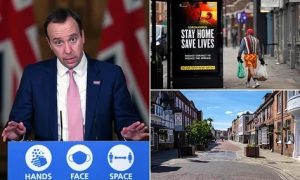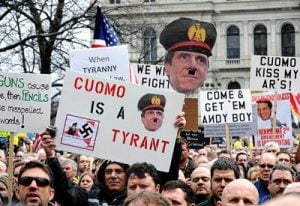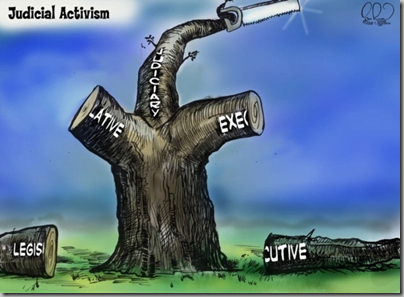The concept that people and governments may incite fear in the general public to achieve political or globalist agendas through emotional bias; it was developed as a sociological framework by Frank Furedi and has been more recently popularized by the American sociologist Barry Glassner. The shadow government has been manufacturing fear through crises, real or imagined, for 100 years or more. Common fear tactics include, war, poverty, pandemics, alien invasion, meteor strike, global warming and terrorism. Upon the collapse of the Soviet Union, Soviet foreign spokesman Gennadi Gerasimov warned the United States, “We have done the most terrible thing to you that we could possibly have done. We have deprived you of an enemy.”
Used under circumstances when the public would otherwise object, shock events are used to overcome major hurdles. False flag events such as the Gulf of Tonkin, Pearl Harbor and 9/11 are examples of shock events in action. Such events usually result in wars which are then used to make fundamental transformative changes to society. In the early 1900’s, the Rockefeller Foundation and Carnegie Endowmnet decided that war was the most effective means of engineering social and cultural changes that would accept a new world order.1
Nazi leader Hermann Göring explains how people can be made fearful and to support a war they otherwise would oppose:
The people don’t want war, but they can always be brought to the bidding of the leaders. This is easy. All you have to do is tell them they are being attacked, and denounce the pacifists for lack of patriotism and for exposing the country to danger. It works the same in every country.
In her book State and Opposition in Military Brazil, Maria Helena Moreira Alves found a “culture of fear” was implemented as part of political repression since 1964. She used the term to describe methods implemented by the national security apparatus of Brazil in its effort to equate political participation with risk of arrest and torture.
Cassação (English: cassation) is one such mechanism used to punish members of the military by legally declaring them dead. This enhanced the potential for political control through intensifying the culture of fear as a deterrent to opposition.
Alves found the changes of the National Security Law of 1969, as beginning the use of “economic exploitation, physical repression, political control, and strict censorship” to establish a “culture of fear” in Brazil. The three psychological components of the culture of fear included silence through censorship, sense of isolation, and a “generalized belief that all channels of opposition were closed.” A “feeling of complete hopelessness,” prevailed, in addition to “withdrawal from opposition activity.”
Former US National Security Advisor Zbigniew Brzezinski argues that the use of the term War on Terror was intended to generate a culture of fear deliberately because it “obscures reason, intensifies emotions and makes it easier for demagogic politicians to mobilize the public on behalf of the policies they want to pursue“.
Frank Furedi, a former professor of Sociology and writer for Spiked magazine, says that today’s culture of fear did not begin with the collapse of the World Trade Center. Long before September 11, he argues, public panics were widespread – on everything from GM crops (rightfully so) to mobile phones, from global warming to foot-and-mouth disease. Like Durodié, Furedi argues that perceptions of risk, ideas about safety and controversies over health, the environment and technology have little to do with science or empirical evidence. Rather, they are shaped by cultural assumptions about human vulnerability.
For nearly half a century, the elusive threat posed by the Soviet Union formed the basis of American foreign and domestic policy. Much of the United States’ political and economic development was in fact a product of the government’s exploitation of a supposed Soviet menace. Gerasimov recognized that the fall of communist Russia denied the American government the ability to exploit the fear of Marxism to its own benefit. It was as if the American government had lost its reason for being.
The United States has a long history of exploiting fear for the purpose of legitimizing its growth. The current generations of American citizens are direct witnesses to over eight decades of such exploitation. In the Great Depression, the government used the fear of capitalism to legitimize previously unforeseen growth in the size of the federal bureaucracy. As the Depression wore on, the state’s inability to spend its way into prosperity led to public skepticism. Thus, the government quickly shifted its focus to the threat posed by Japan, Germany, and their allies. Perhaps most relevant to current Americans was the fear of communism perpetuated through the Cold War. No less than two wars were justified by this anticommunism, as were political repression and a radical expansion of bureaucracy and the military-industrial complex.
As Gerasimov suggested, the fall of the Soviet Union left the US government without a justification for its existence. The state no longer enjoyed an overbearing threat with which to distract the masses while it grew in size.
Unfortunately, this situation did not last long. Indeed, the past decade witnessed the development of an overwhelming American fear of terrorism. Americans have apathetically allowed the repression of their freedoms in the name of some greater cause (a cause, ironically, justified as a mission to preserve American freedoms).
While support of American imperialism, otherwise termed “counterterrorism,” has recently waned, the government is now reinforcing its legitimacy by once again intervening on behalf of the common man against the capitalist system. By this means the United States’ bureaucracy continues to grow virtually unhampered, and individual freedom has necessarily decreased.
Our government’s authority is based on the notion that only the state can protect the American people from the vices of greed and opposing ideologies. The state thrives off the creation of a false dichotomy between stateless ruin and state-induced prosperity. The actual relationship is quite clear, however: the state itself is actually the people’s greatest threat.
As the Stoic philosopher Seneca pointed out:
“There are more things…likely to frighten us than there are to crush us; we suffer more often in imagination than in reality.” (Letters from a Stoic, Seneca)
While some of these imagined fears are of one’s own making, many are the consequence of narratives created by those in positions of power. Individuals looking to take advantage of, and manipulate others, have long realized the power of fear. When one is gripped by fear of a threat, real or imagined, their rational and higher cognitive capacities shut down, making them easily manipulable by anyone that promises safety from the threat.
“No passion so effectually robs the mind of all its powers of acting and reasoning as fear”, wrote the 18th century philosopher Edmund Burke.
Ruling classes for thousands of years have understood the power of intentionally invoking fear in their subjects as a means of social control. Henri Frankfort, in his book the Intellectual Adventure of Ancient Man, noted that between 1800 and 1600 BC a fear psychosis spread through Ancient Egypt, precipitated by the invasion of foreign rebels hungry for power and conquest. Initially this fear psychosis was justified by a real threat, yet even when these foreigners were successfully driven far away from Egypt, the ruling powers sought to artificially maintain fear among the population – realizing that a fearful population is easier to control than a fearless one.
Benjamin Franklin once said: “Those who would give up essential Liberty, to purchase a little temporary Safety, deserve neither Liberty nor Safety.”
The shadow government and the co-conspirators within governments worldwide and a its power structure, create depressions, famines, and pandemics for their own gain. For instance, pandemics: Drug companies make money on the vaccine and the drugs used to treat COVID-19 patients. State governments receive federal money to “fight the virus.” Researchers win promotions. Public health agencies obtain more funding, and more power. Financiers buy up devalued properties at bargain prices. At the top of the ladder, key plotters contrive selling the story of a new killer virus, because they intend to use it to lock down the planet. Why? Because they want to torpedo economies and move in on the wreckage and build a new economic, social, and political world order.1 Masks, social distancing, lockdowns, etc. are all proven to not work to control a viral outbreak… they can have no effect! They are about control and getting people to obsess over safety in order to give up their freedoms.
Obsessing with safety creates sick minds and a sick society. Here’s why…
https://www.youtube.com/watch?v=e3EsCIjvrSw
Robert Higgs famously documented in his 1987 book, Crisis and Leviathan: Critical Episodes in the Growth of American Government, and in later works, the “ratchet effect” in which governments vastly expand during a crisis, but never shrink back to its former scale once the crisis is over. By surveying the effect of wars, financial panics, and other crises over the course of a century, Higgs showed that most government growth occurs in sporadic bursts during emergencies, when politicians enact “temporary” programs and regulations that never get fully abolished. New Deal bureaucracies and subsidies persisted long after the Great Depression, for example, and the U.S. military didn’t revert to its prewar size after either of the world wars.
In The Power of Bad, social psychologist Roy Baumeister and John Tierney drew on Higgs’s work to argue that the greatest problem in politics is what they call the Crisis Crisis—the never-ending series of crises, real or imagined, that are hyped by the media and lead to cures too often worse than the disease. It’s a perpetual problem because it’s so deeply rooted in human psychology, as Higgs explained in a 2005 essay, “The Political Economy of Fear.”
“Without popular fear, no government could endure more than twenty-four hours,” Higgs wrote, explaining how the earliest kingdoms were founded by warriors who augmented their authority with the help of religious leaders. “The warrior element of government puts the people in fear for their lives, and the priestly element puts them in fear for their eternal souls. These two fears compose a powerful compound—sufficient to prop up governments everywhere on earth for several millennia.”
Then, in the nineteenth century, came new fears to justify the creation of the welfare state. As Higgs noted: “People were told that the government can and should protect them from all sorts of workaday threats to their lives, livelihoods, and overall well-being—threats of destitution, hunger, disability, unemployment, illness, lack of income in old age, germs in the water, toxins in the food, and insults to their race, sex, ancestry, creed, and so forth. Nearly everything that the people feared, the government then stood poised to ward off.” Read more HERE
Impact of Fear and Anxiety
Fear is a human emotion that is triggered by a perceived threat. It is a basic survival mechanism that signals our bodies to respond to danger with a fight or flight response. As such, it is an essential part of keeping us safe. However, when people live in constant fear, whether from physical dangers in their environment or threats they perceive, they can become incapacitated. Fear prepares us to react to danger. Once we sense a potential danger, our body releases hormones that:
- Slow or shut down functions not needed for survival (such as our digestive system)
- Sharpen functions that might help us survive (such as eyesight). Our heart rate increases, and blood flows to muscles so we can run faster.
Our body also increases the flow of hormones to an area of the brain known as the amygdala to help us focus on the presenting danger and store it in our memory.
Living under constant threat has serious health consequences.
- Physical health. Fear weakens our immune system and can cause cardiovascular damage, gastrointestinal problems such as ulcers and irritable bowel syndrome, and decreased fertility. It can lead to accelerated ageing and even premature death.
- Memory. Fear can impair formation of long-term memories and cause damage to certain parts of the brain, such as the hippocampus. This can make it even more difficult to regulate fear and can leave a person anxious most of the time. To someone in chronic fear, the world looks scary and their memories confirm that.
- Brain processing and reactivity. Fear can interrupt processes in our brains that allow us to regulate emotions, read non-verbal cues and other information presented to us, reflect before acting, and act ethically. This impacts our thinking and decision-making in negative ways, leaving us susceptible to intense emotions and impulsive reactions. All of these effects can leave us unable to act appropriately.
- Mental health. Other consequences of long-term fear include fatigue, clinical depression, and PSTD.
So whether threats to our security are real or perceived, they impact our mental and physical wellbeing.1
Dr. Wendy Suzuki, NYU Neuroscientist, professor and author of Healthy Brain Happy Life has famously studied long-term memory, creativity, anxiety, and how exercise affects our brain and overall health. She says:
We have a lot of knowledge about what happens when we are in a constant state of fight-or-flight. And those examples come from syndromes like PTSD, experiencing terrible situations for a long period of time. Here we come to a concept of brain plasticity, which basically means that what you’re experiencing can change your brain. It can make your brain grow so that it’s nice and fluffy and strong or it can shrink it down. So, guess what PTSD does? It can shrink the size of your temporal lobe and increase the size of the amygdala structure that is processing fear information. It also shrinks the size of a key brain area that I’ve studied for the last 25 years called the hippocampus, which is critical for long-term memory. The hippocampus has been more recently implicated in creativity and imagination. Because what imagination is, is taking those things you have in your memory and putting them together in a new way. So just in the way that the hippocampus allows us to think about the past and memory, it also allows us to imagine the future. Long-term stress is literally killing the cells in your hippocampus that contribute to the deterioration of your memory. But it’s also zapping your creativity.
She points out the “antidote is love conditioning. We know that the same circuitry that is so powerful in creating these negative associations – the fear conditioning – also exists for love conditioning. But it’s up to us to create that love conditioning… Find something that you love and find a way to bring that up for you.” In addition she points out the importance of exercise to counter a constant state of fear (such as that perpatrated on the world by the coronavirus fake pandemic). “It stimulates the release of key neurotransmitters associated with good mood – dopamine, serotonin, noradrenaline. All of them go up with exercise.”2
Here’s an excellent video on how fear and love each affects the chemistry and biology of the body:
https://www.youtube.com/watch?v=AgifktrlMEQ
Spiritual Impact of Fear
Rudolf Steiner was an Austrian philosopher, educator, and spiritualist, and over the course of his life he published numerous books and papers on the science of spirituality. He viewed the human body as a spiritual vessel, open to occupation by other entities. To be conscious of these forces was to have the power to reject their negative influence. To remain unconscious of them was to be a leaf in their wind, and spiritual cultivation was the key to developing conscious awareness of them.
If people express the natural human inclination toward spiritual growth, they free themselves from fear and anxiety, and effectively develop a sort of immunity to the influences of negative entities. If not, our vibration attracts hostile spirits and we fall unconsciously unto their influence.
“There are beings in the spiritual realms for whom anxiety and fear emanating from human beings offer welcome food. When humans have no anxiety and fear, then these creatures starve… If fear and anxiety radiates from people and they break out in panic, then these creatures find welcome nutrition and they become more and more powerful. These beings are hostile towards humanity.
“Everything that feeds on negative feelings, on anxiety, fear and superstition, despair or doubt, are in reality hostile forces in supersensible worlds, launching cruel attacks on human beings, while they are being fed. Therefore, it is above all necessary to begin with that the person who enters the spiritual world overcomes fear, feelings of helplessness, despair and anxiety.
“But these are exactly the feelings that belong to contemporary culture and materialism; because it estranges people from the spiritual world, it is especially suited to evoke hopelessness and fear of the unknown in people, thereby calling up the above mentioned hostile forces against them.”
With such profound global fear, anxiety, and panic over the present pandemic, many are exposing their own spiritual sicknesses and acquiescing to any recommended behavior or intervention that might alleviate these emotions. Along with this is the push to vaccinate 7 billion healthy people.
Nearly 100 years ago, in a series of 14 essays published under the title, The Fall of the Spirits of Darkness, Steiner issued a warning to future generations about a possible measure of mass control, quite similar to the visions presented by Orwell and Huxley. Steiner foresaw a future when vaccines could steal our spiritual nature.
A Covid-19 vaccine trial volunteer stated in September 2020 after being injected with the experimental jab: “They’ve killed God; I can’t feel my God, my soul is dead.” AstraZeneca said he was the second volunteer to “develop neurological problems.”
The Great Depression and World War II
The Great Depression witnessed one of the earliest large-scale increases in federal power in 20th-century American history. The state, looking to find a scapegoat for the disaster, was quick to demonize capitalism and greedy irrationalism as the culprits behind the dramatic depreciation of the general standard of living. The solution was benign government intervention, guaranteeing the laborer a living wage and promising progress and growth through central management. The fear of economic collapse, poverty, and misery led the American people to largely ignore, or even allow and accept, the growth of bureaucracy.
Uninterested in having any opposition, the state either bought off differing politicians or purged those who stood in the system’s way, most through the use of the newly created Internal Revenue Service. While pointing at the ills caused by free and unfettered businessmen, Hoover became the largest peacetime spender in the history of the country; Roosevelt later shamed Hoover with even greater fiscal expenditure. Despite large spending programs and rampant bureaucratic growth, neither president successfully ended the depression.
Failing to stimulate the United States out of the depression, the American government desperately needed a new enemy to distract the country’s attention with. The rise of Adolf Hitler in Europe and the growing threat of Japanese imperialism in the Pacific provided Roosevelt with the perfect target. Intervention in Europe was justified not merely on account of helping the British or opposing German fascism. The government instead built a culture of fear.
Propaganda posters depicting German jackboots crushing small-town American churches, or Germanic invasion forces converging on New York City, were distributed throughout America’s cities. Another such poster depicted the Germans and Japanese looming ominously over the United States, one with a pistol and the other with a bloody dagger, reading, “Our homes are in danger now!” The Roosevelt administration made it clear that the intentions of the Axis powers were to threaten the freedoms of Americans proper.
Creating a threat was necessary if Roosevelt was to persuade the noninterventionist doves, many of whom still peppered the bureaucracy. Indeed, after the First World War only a direct threat could justify American involvement in a new European war. To this end, Roosevelt’s administration managed not only to run a considerably large propaganda campaign, but also to coax the Japanese into a clear provocation.
The Roosevelt administration’s campaign of escalation toward war culminated with the Japanese attack on Pearl Harbor and a number of other American territorial assets in the Pacific Ocean. A direct attack on the United States provided all the justification necessary to intervene both in the Pacific and in Europe. The result was a two-theater war, costing the United States nearly 300,000 lives (and many more wounded), and leaving Europe and Japan almost completely shattered. All the while, the American state continued to grow in size, power, and capability.
Anticommunism and the Cold War
After the end of the Second World War, the Soviet Union replaced the defeated Axis Powers as the greatest threat to the United States’ freedom. Soviet Russia was no less than the heart and origin of global communism. It infected much of East Asia, including North Korea, China, and Vietnam. The Red Army posed a direct menace to free and capitalist Western Europe and, indeed, to the free world in general. The perceived Soviet threat provided the rationalization for the Cold War, which ensued between 1946 and 1991. In the period between 1946 and 1991 Americans saw quite possibly the greatest expansion of bureaucracy in the US government — ironic for a country purportedly focused on fighting communism.
Fear of communism validated American involvement in two major wars: Korea and Vietnam. Justified or not, both wars held great implications regarding the growth of the state.
The first of these two major wars was fought in Korea, between 1950 and 1953. The Korean War spelled the end of the anti-interventionist movement in the US government. The post–World War demobilization proved excessive for a country intending to challenge global Marxism. The North Korean invasion of southern Korea in mid-1950 caught the United States, in the midst of said demobilization, severely unprepared for a new war. The US government was determined to never be caught off guard again, and the years following the end of the Korean War witnessed the development of the American military-industrial complex and the foundation of a permanent wartime military.
The Korean War confirmed a new age of militarism, where the United States was ready and willing to intervene in the name of anticommunism (or, at least, behind the veil of anticommunism). Forming powerful alliance blocs across the world, both the United States and the Soviet Union prepared for their inevitable confrontation — the “Third World War.”
Fear of inevitable war, and the consequent exploitation of such fear by the state, led to the creation of a soon-sprawling military-industrial complex. A growing military required armaments, encouraging the enlargement of a permanent war-materiel industry. Given the public-private nature of this particular market, it is unsurprising that it soon devolved into a system in which companies would directly lobby government for contracts, and where the company with the most friends in government usually won. The establishment of a network of favoritism led directly to a situation in which politicians readily justified different military programs just to necessitate the continued production of war supplies. As the military-industrial complex grew in size, it became so important that politicians only needed to point to the vast amount of workers it employed in order to justify its existence. This, in fact, is the form in which the military-industrial complex exists to this very day. It is a relic of the Cold War.
The government consistently exploited the fear of communism to meet the needs of individual bureaucrats. Most well known is the case of McCarthyism. Senator Joseph McCarthy ingeniously used the fear of communism to discredit his political opponents and protect himself from criticism. As a method of censorship, he had hundreds of individuals, most related to the entertainment industry, blacklisted. While Senator McCarthy’s purge represented an extreme case, which ended by the late-1950s, fervent state-sponsored anticommunism did not recede.
The roots of the United States’ second major anticommunist war, the Vietnam War, were firmly planted in the mid-1950s, with the dissolution of French Indochina into two independent Vietnams. While the North fell under communist rule, the South consolidated under the brutal leadership of Ngo Dinh Diem. The South, firmly anticommunist, was promptly buttressed by the fiscal and military support of the Eisenhower administration.
The Diem regime’s brutal method of governance, including enslavement and execution, triggered the beginning of the Viet Minh insurgency. The United States responded by declaring unwavering support for the South (lest the United States lose even more face, given the debacle at the Bay of Pigs and the erection of the Berlin Wall in Germany). By 1963, 16,000 American personnel were deployed in Vietnam. This rose to a couple hundred thousand within the next two years.
While the Vietnam War proved to be an absolute disaster, its most lasting legacy was not the cultural antistate revolution that it sparked in the United States. Rather, despite the mounting opposition to the war, it managed to finally solidify the bureaucracy’s ability to wage war without a congressional declaration (despite the War Powers Resolution, which was supposedly meant to reverse the extreme powers granted to the presidency by the Gulf of Tonkin Resolution). This made future war efforts much easier to organize, leading to a number of military operations during the 1980s, including Grenada and Panama.
In retrospect, especially for those who have no recollection of the era, it is rather difficult to understand the culture of fear imposed by the state. Through the exploitation of the public’s fear of communism, the United States legitimized the military-industrial complex, instigated short anticommunist purges, launched two major wars (and many smaller ones), and supported several brutal dictatorships throughout the world. Ultimately, the Soviet Union fell without a single shot fired in anger between it and the United States. No world war materialized. Communism fell not by the sword, but by its own internal inconsistencies.
Ironically, the Cold War’s losers were the citizens of the “free world,” who, by turning a blind eye to rampant government growth were enslaved by their own “protectors.” Soviet foreign spokesman Gerasimov warned the American government of the great harm the Soviets had inflicted by collapsing. Government-sponsored slavery suddenly lost its principal justification.
Terror
After the fall of the Soviet Union, the new centerpiece of government’s fearmongering soon emerged. A series of minor bombings in the 1990s and finally the ghastly attack on the World Trade Center and the Pentagon on September 11, 2001, confirmed the Soviet Union’s replacement — global terrorism.
The nation was swept with terror frenzy. Like communism before it, the elusive threat of terrorism justified two wars and numerous infringements on the individual rights of American citizens. The Bush administration launched two military invasions within two years of each other — Afghanistan and Iraq. Both wars were supposedly fought to protect Americans from the suspect threat of global terrorism.
It was argued, and is argued to this day, that terrorism posed a threat to American individual freedoms. Yet, the greatest threat to American freedom proved to be, not the terrorists, but the very government that purportedly protects Americans. Indeed, in the years following the September 11 attacks, the Bush administration managed to perpetrate some of the most severe infringements on individual rights since the Roosevelt administration. All the while, Al-Qaeda has yet to seriously threaten the United States.
Furthermore, the invasions of Iraq and Afghanistan left Al-Qaeda virtually untouched. While Afghanistan supposedly harbored Al-Qaeda figurehead Osama bin Laden, Al-Qaeda was already widely dispersed throughout other countries. And of course Iraq had no meaningful relationship with Al-Qaeda.
New Tools of Repression
Unsurprisingly, the two wars in the Middle East have taken their toll on the people’s trust in the state. Support for continued interventionism abroad continues to wane, as it becomes clear that neither of the wars has much to do with global terrorism or the protection of American freedoms. However, the state has once again shifted policy to cope with the change in public opinion.
The fear of terrorism has by and large been replaced by the alleged threat of capitalism and animal spirits. The threat once again becomes greed, and as usual, there is only one solution — embracing the state. Naturally, the masses have once again fallen for this appeal to fear. Without government intervention, alleges the regime, the country will fall into a spiral of poverty and misfortune. The people, otherwise free, will find themselves the downtrodden slaves of the free market.
The government thrives on creating these false dichotomies: war or invasion, militant anticommunism or a global communist revolution, war or terrorism, economic interventionism or economic misery. It offers the masses two choices, utopia or hell. The one, it claims, can only be provided by the state, while the other is the product of an unprotected and anarchic society. These illogical fears have tended to win over reason, and the government continues to grow unchecked.
A century of war, corruption, interventionism, and inflation have failed to dissuade the public from apathetically accepting government growth. This phenomenon can perhaps be explained by noting the collective rejection of reason and logic, spread through the system by the ranks of intellectuals and academics who willingly accept this transition to irrationalism. For whatever reason, bureaucratic expansion has been left virtually unopposed.
Fortunately, the recent dismantling, by means of the Internet, of the state’s monopoly on education has allowed for the formation of pockets of resistance. These represent the development of a liberal counterrevolution to the now mainstream culture of statolatry — a return of reason. Before such a movement can set in, however, the culture of fear created by government must be dispelled. Man must not allow himself to fall prey to the state’s exploitation of his emotions. Man must, once again, recognize the fallibility of the state and the availability of other options.
Author: Contact Jonathan M. Finegold Catalan for Mises.org
In order to perceptively comprehend the psychological basis of such absurd and fabricated threats which instill existential fears:
whose import to enabling “imperial mobilization” was clearly envisaged by Zbigniew Brzezinski in 1996 in The Grand Chessboard:
“It is also a fact that America is too democratic at home to be autocratic abroad. This limits the use of America’s power, especially its capacity for military intimidation. Never before has a populist democracy attained international supremacy. But the pursuit of power is not a goal that commands popular passion, except in conditions of a sudden threat or challenge to the public’s sense of domestic well-being. The economic self-denial (that is defense spending), and the human sacrifice (casualties even among professional soldiers) required in the effort are uncongenial to democratic instincts. Democracy is inimical to imperial mobilization.” (pgs. 35-36);
whose raison d’être as the primary method for advancing “the “national interest” by means of organized violence”, was taken as axiomatic in the 1963-64 secret study reported in the 1967 book The Report From Iron Mountain:
“It must be emphasized that the precedence of a society’s war-making potential over its other characteristics is not the result of the “threat” presumed to exist at any one time from other societies. This is the reverse of the basic situation; “threats” against the “national interest” are usually created or accelerated to meet the changing needs of the war system. … The military, or ostensible function of the war system requires no elaboration; it serves simply to defend or advance the “national interest” by means of organized violence. It is often necessary for a national military establishment to create a need for its unique powers—to maintain the franchise, so to speak. And a healthy military apparatus requires “exercise,” by whatever rationale seems expedient, to prevent its atrophy.” (pgs. 31,33);
whose utility for effectively embarking on the “military transformation” required to achieve “full spectrum dominance” that wasn’t “stillborn”, was openly declared in the Project for the New American Century (PNAC) report titled Rebuilding America’s Defenses:
“Further, the process of transformation, even if it brings revolutionary change, is likely to be a long one, absent some catastrophic and catalyzing event – like a new Pearl Harbor. … Until the process of transformation is treated as an enduring military mission – worthy of constant allocation of dollars and forces – it will remain stillborn” (pgs. 51,58) ;
and whose necessity for rapidly transforming an entire society, nation, or the whole world, in the direction desired by the controlling oligarchy, was even discovered in the 1908 minute books of the Carnegie Endowment for Peace by the Congressional Reece Committee investigator Norman Dodd in 1954, and related by him in an interview before his death in 1982, The Hidden Agenda of Tax Exempt Foundations for World Government:
“We are now at the year 1908, which was the year that the Carnegie Foundation began operations. In that year, the trustees, meeting for the first time, raised a specific question, which they discussed throughout the balance of the year in a very learned fashion. The question is: “Is there any means known more effective than war, assuming you wish to alter the life of an entire people?” And they conclude that no more effective means than war to that end is known to humanity. So then, in 1909, they raised the second question and discussed it, namely: ‘How do we involve the United States in a war?’” ;
please see social engineering principles in Further Study of Operation Gladio, Edward Bernays and Human Resources.
Also see Myth of the Cave in Plato’s 2500 years old classic The Republic, Book VII, page 300 (book PDF).
Chronological History of the Culture of Fear / Fear-mongering

WHO Declares Monkeypox Outbreak a Global Health Emergency

Mattias Desmet Releases ‘The Psychology of Totalitarianism’

The First European Case of Monkeypox Confirmed

CNN Director Admits Network Engaged in ‘Propaganda’ to Remove Trump and Promote Pandemic Fear

Matt Hancock told aides he wanted to “frighten the pants off everyone” about the Kent variant of Covid to ensure compliance with lockdown rules

Joe Biden Says 250,000 Americans will Die From Covid in the Next Few Weeks, but “I Don’t Want to Scare Anybody”

White Coat Summit II Held Over the Weekend in Washington D.C.

Killer Cuomo Admits in Call with Jewish Leaders: Coronavirus “Initiatives Are Not Based on Science but Are Based Out of Fear”

White Coat 2-Day Summit Begins in DC to Dispel Misinfo and Empower Americans to Stop Living in Fear




